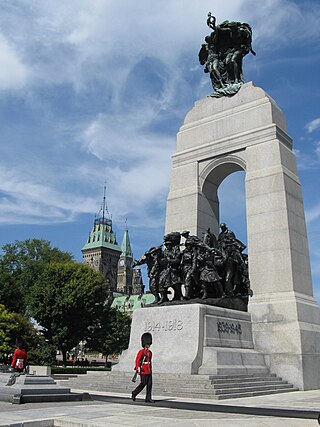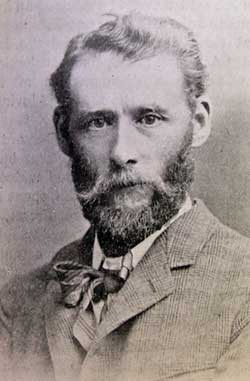 The memorial in 2011 | |
 | |
| 43°39′44.6″N79°23′23.4″W / 43.662389°N 79.389833°W |
The Ontario Police Memorial is located in Toronto's Queen's Park, in Ontario, Canada. The monument was dedicated in 2000. [1]
 The memorial in 2011 | |
 | |
| 43°39′44.6″N79°23′23.4″W / 43.662389°N 79.389833°W |
The Ontario Police Memorial is located in Toronto's Queen's Park, in Ontario, Canada. The monument was dedicated in 2000. [1]
Designed by Siggy Puchta, the memorial features two figures atop a granite plinth: a male police officer in 1950s duty dress and a female police officer in 2000s duty dress. [1] [2] The monument includes a list of names, in random order, of every Ontario police officer who died while serving the public. [3] As of 2008, 234 names were added to the wall. [4] The earliest name recorded on the memorial is that of Constable John Fisk, who drowned in Lake Ontario in 1804 when the vessel he was using to transport a prisoner sank during a storm. [4]

Parliament Hill, colloquially known as The Hill, is an area of Crown land on the southern bank of the Ottawa River that houses the Parliament of Canada in downtown Ottawa, Ontario, Canada. It accommodates a suite of Gothic revival buildings whose architectural elements were chosen to evoke the history of parliamentary democracy. Parliament Hill attracts approximately three million visitors each year. The Parliamentary Protective Service is responsible for law enforcement on Parliament Hill and in the parliamentary precinct, while the National Capital Commission is responsible for maintaining the nine-hectare (22-acre) area of the grounds.

Queen's Park is an urban park in Downtown Toronto, Ontario, Canada. Opened in 1860 by Edward, Prince of Wales, it was named in honour of Queen Victoria. The park is the site of the Ontario Legislative Building, which houses the Legislative Assembly of Ontario. The phrase "Queen's Park" is regularly used as a metonym for the Government of Ontario or the Legislative Assembly of Ontario.

The Tomb of the Unknown Soldier is a tomb situated before the National War Memorial in Confederation Square, Ottawa, Ontario. The tomb is dedicated to Canadian service members, and holds the remains of an unidentified Canadian soldier who died in France during the First World War; selected from a Commonwealth War Grave near Vimy, in the vicinity where the Battle of Vimy Ridge took place. A similar memorial was installed in June of 2024 at the National War Memorial in St. John's, Newfoundland to contain the unidentified Great War remains of a soldier of the Royal Newfoundland Regiment.

The Queen's Own Rifles of Canada is a Primary Reserve regiment of the Canadian Armed Forces, based in Toronto. The regiment is part of 4th Canadian Division's 32 Canadian Brigade Group. It is the only reserve regiment in Canada to currently have a parachute role. The regiment consists of the reserve battalion, the Regimental Association, and the Regimental Band and Bugles. The official abbreviation is The QOR of C, but the name is often abbreviated to QOR.

The National War Memorial, titled The Response, is a tall, granite memorial arch with accreted bronze sculptures in Ottawa, Ontario, designed by Vernon March and first dedicated by King George VI in 1939. Originally built to commemorate the Canadians who died in the First World War, it was in 1982 rededicated to also include those killed in the Second World War and Korean War and again in 2014 to add the dead from the Second Boer War and War in Afghanistan, as well as all Canadians killed in all conflicts past and future. It now serves as the pre-eminent war memorial of 76 cenotaphs in Canada. In 2000, the Tomb of the Unknown Soldier was added in front of the memorial and symbolizes the sacrifices made by all Canadians who have died or may yet die for their country.

The Ontario Legislative Building is a structure in central Toronto, Ontario, Canada. It houses the Legislative Assembly of Ontario, and the viceregal suite of the Lieutenant Governor of Ontario and offices for members of the provincial parliament (MPPs). The building is surrounded by Queen's Park, sitting on that part south of Wellesley Street, which is the former site of King's College, which was leased from the university by the municipal government of Toronto in 1859, for a "peppercorn" payment of CAD$1 per annum on a 999-year term. The southern portion of the site was later handed over to the provincial government.

The Adam Beck Memorial is a memorial in Toronto, Ontario, Canada in honour of the founder of Ontario Hydro, Sir Adam Beck. It is located in the landscaped median of University Avenue just south of Queen Street West. Designed by sculptor Emanuel Hahn, the monument was the first place entry in a design competition for a memorial to commemorate Adam Beck. It was unveiled in 1934.

The Canadian Police and Peace Officers' Memorial is a memorial in Ottawa, Ontario, commemorating approximately 900 Canadian law enforcement officers killed in the course of their duties. Dedicated in 1994, it is located at the northwest corner of the Parliament Hill grounds, overlooking the Ottawa River. The memorial consists of the Police Memorial Pavilion, a reconstruction of a 1877 gazebo by Thomas Seaton Scott, and a glass-and-steel perimeter wall etched with the names of the fallen officers, which was designed by landscape architectural firm Phillips Farevaag Smallenberg.

Hamilton Thomas Carlton Plantagenet MacCarthy was one of the earliest masters of monumental bronze sculpture in Canada. He is known for his historical sculptures, in particular his Pierre Dugua, Sieur de Mons at Annapolis Royal, Nova Scotia (1904) as well as Samuel de Champlain overlooking Parliament Hill on Nepean Point, Ottawa (1915), next to the National Gallery of Canada. His monument to the Ottawa volunteers who died in the South African War (1902) was moved to Confederation Park in 1969 after several moves. Other works include that of Ottawa mayor, Samuel Bingham, in Notre-Dame Cemetery in Vanier.

The Shrine Peace Memorial is a memorial sculpture on the grounds of Exhibition Place in Toronto, Ontario, Canada. The monument was presented to the people of Canada on June 12, 1930 by the Ancient Arabic Order Nobles of the Mystic Shrine as a symbol of peace and friendship between the United States and Canada. It is also meant as "an ongoing reminder that Freemasonry actively promotes the ideals of peace, harmony, and prosperity for all humankind". The location is thought to be the location that American troops landed during the War of 1812 for the Battle of York.

Monument to the War of 1812, also called Toy Soldiers, is a War of 1812 war monument in Toronto, Ontario, Canada. Designed by Douglas Coupland and unveiled in 2008, the monument includes two Styrofoam sculptures over a stone plinth, and commemorates the successful defence of British North America against American forces in the War of 1812.

Coronation Park is a park and veteran's memorial in Toronto, Ontario, built to mark the coronation of King George VI in 1937. Most trees are planted to honour the Canadian men and women who participated in the First World War and earlier wars, while others commemorate subsequent coronations of Canadian monarchs. Constructed on landfill on the shore of Lake Ontario during the Great Depression, many workers on relief were used. The park also has the Victory-Peace monument, located at the water's edge. To the east is HMCS York, the naval barracks; to the north is Fort York and the Fort York Armoury; and, to the west, is Exhibition Place, once the site of New Fort York.
Walter Yarwood was a Canadian abstract painter and a founding member of Painters Eleven. Yarwood became known for his painting beginning in the 1950s. During the 1960s he completed a number of public sculptures in Ontario, Quebec and Manitoba.

The Ontario Firefighters Memorial is a monument in Toronto's Queen's Park, in Ontario, Canada.

The Northwest Rebellion Monument is a memorial installed in Toronto's Queen's Park, in Ontario, Canada.

The Post One Monument in Toronto's Queen's Park commemorates Canada's centennial. Unveiled in 1967, the monument functions as a geodetic survey marker and has a time capsule that is slated to be opened in 2067.

A statue of William Lyon Mackenzie is installed in Toronto's Queen's Park, in Ontario, Canada.

The Canadian Volunteer Monument is installed in Toronto's Queen's Park, in Ontario, Canada. The memorial was dedicated in 1870.

The 48th Highlanders of Canada Regimental Memorial is a monument in Toronto's Queen's Park, in Ontario, Canada. The monument was erected in 1923.